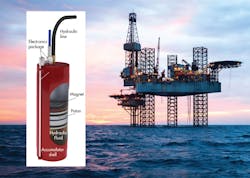Transducer Monitors Accumulator Piston Position
Accumulators offer multiple benefits to hydraulic systems. Accumulators can save energy by supplementing pump flow during peak power demands, thereby reducing the size of the pump and motor in the hydraulic power unit. They can also store energy for emergency standby power and smooth out rapid changes in system pressure.
The list goes on, but one limitation of accumulators is the difficulty in trying to determine the amount of charge gas in an accumulator. If a hydraulic system is completely depressurized, an accumulator’s piston will be bottomed out and provide maximum volume for the charge gas. You can then use a pressure gauge to determine the pressure of the charge gas, but you still need to know the temperature of the gas.
Rota Engineering’s AC Series linear transducers monitor position of an accumulator’s piston through the accumulator wall and can tolerate ocean depths of 20,000 ft., making it well-suited to subsea applications.
You could avoid all this trouble if you knew the position of the piston in the accumulator. Different solutions have been presented to sense piston position in an accumulator, but they usually require drilling and tapping a hole into the accumulator end cap to accommodate some type of linear sensor. This type of modification requires precise machining and sealing to prevent compromising the integrity of the accumulator.
However, Rota Engineering, Bury, England, recently introduced its AC series linear transducers that install entirely on the exterior of a piston accumulator. The transducer uses Hall-effect technology to sense a magnet embedded in a piston through up to 1-in. of carbon steel. The absolute, non-contact technology senses linear position of a magnetic field through the accumulator wall to provide electronic feedback of the piston position.
Perhaps the greatest benefit of the AC series is that it allows monitoring accumulator piston position while a machine is operating. Electronic output can be used to assess machine operation to aid fine tuning of operation and trend analysis for detecting gradual wear or internal leakage of components within the circuit.
Initial offerings of the AC transducer accommodate accumulator bores from 4 to 12 in., nominal resolution of 10 mm, and virtually unlimited lengths starting at 4 in. Standard electrical outputs are voltage, current, PWM, and CANbus. It is rated for industrial and use at subsea depths to 20,000 ft. with A Ex-, IECEx-, and ATEX-approved versions available as options.



